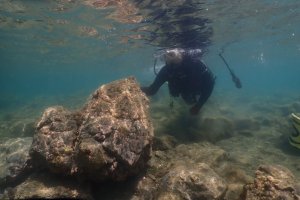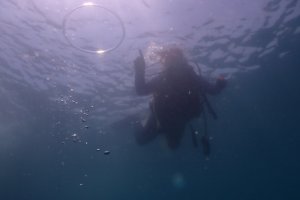The largest coral colony in the northernmost part of the world is found in the ocean off the southern tip of the Kii Peninsula! Here the subtropical zone meets the temperate zone. This is a unique situation which means you can see many different kinds of fish from both zones, provided you dare to get into the water and dive.
Nanki and the Kuroshio
Nanki is the traditional name of the south of the Kii Peninsula. This is where Kushimoto, a fishermen’s town and a holiday resort, is located. It is famous for the Hashikui, a bizarre rock formation that stand just off the coast in the ocean. But, there is more to Kushimoto than first meets the eye!
Well-known among the Japanese lovers of diving, this town is home to no less than 27 dive shops. Kushimoto ranks well in the league of Japan’s top dive spots, which also include Ishigaki Island in Okinawa and Kashiwa Island in Kochi Prefecture, Shikoku. What these locations have in common is that they are straddled by the Kuroshio, a warm ocean current.
Welcome at Nanki Seaman’s Club
One of the dive shops is Nanki Seaman’s Club. In operation for 30 years, this is one of the well-established dive shops in Kushimoto.
Their office is just off Road 42 out of Kushiomoto Town, or 10 minutes’ drive from Kushimoto Station. A shuttle service from the station to the clubhouse is also available.
In summer the four experienced instructors, owner To-chan, chief instructor Iwa-chan, instructor Koike-kun and instructor Hiroshi, take care of beginners and advanced divers. All divers and wannabe divers are welcome from age 10 to open-ended provided you are healthy.
They run three boats, with the biggest fitting about 30 people. On weekdays only 10 to 15 people stop by for a dive but on the weekend and on national holiday is can be many more.
At base, there is a spacious office with tables and benches for a rest before or after your dive. There are showers, changing rooms and lockers for small luggage.

Preparing for your first dive ever
If you have never done a dive in your life before, like the author of this article, it can be quite scary to sign up for a half-day scuba dive experience, even more so in a foreign country.
The dive instructors at Nanki Seaman’s Club know that. Hence, they have prepared a PowerPoint Presentation in English that helps explain the equipment, the instructions to follow and especially the methods of trouble shooting, which is what you want to pay extra careful attention to.
Experienced divers can skip this part of the article, but for beginners it might be interesting to know the different parts of the dive gear, and you do well to remember them quickly.
Apart from the goggles on your face, the cylinder (a tank full of air) on your back and a belt with weights around your waist, there are also the following: a regulator, a tube through which you get air; an ‘octopus’, another tube that is used to share air; a pressure gauge, to check air pressure and a BCD, short for Buoyancy Control Device, connected to the Inflator/ Deflator nose.
Next you need to know hand signals. This is most important, as obviously you cannot talk to the instructor while under water. All hand signals will be explained to you and you practice a bit while looking at the PowerPoint Presentation to help you remember these signals.
Next comes trouble-shooting, and there is quite a bit that can go wrong, especially on your first dive. The instructor explains how to make your mask clear. This means how to remove water that entered the mask. Then you also need to know how to recover your regulator in case this breathing device slips out of your mouth while under water. Finally, you need to know how to deal with any ear pressure and headache that might develop due to the water pressure.
All the equipment will be put on top of a wet suit that the dive shop rents out to you. You will also get dive shoes, fins and dive gloves for rent. The only thing you need to bring is a swimming costume which you wear underneath, and a ribbon to hold your hair back in case of long hair. Putting a wet suit on for the first time can be a struggle in itself.
You will be carrying about 15 kg of weight on you, including over 10 kg of the cylinder, regulator and BCD plus 4/5 kg of stone weights. You need to carry this from the car, which takes you to near the dive spot, down to the ocean shore and back, which can feel like a drag.
Once in the water, you will practice how to breathe underwater while still standing on the ground. Then, you will practice to deflate and inflate to sink or rise in the water. Sinking to the ground, you will stretch your body and try to float in the water. The instructor will check the correct balance of your weights. If the balance is off, you start ‘rolling’, which is a very unpleasant experience for first-timers.

Enjoy the underwater world, if you can
Getting through these instructions and the checks and testing takes up a lot of time but it is very important for your safety. Once the instructor is satisfied that you are OK, you are off for your first dive. Try to enjoy it.
The actual ‘taiken’ dive experience lasts only 30 minutes and you don’t dive deeper than 5 meters. This might seem short, both in terms of time and depth, but actually it is about right for a novice. This will be diving near the beach. Experienced divers who hold a diving license go down deeper, further out in the ocean, for 50 minutes to 1 hour. Those with a diving license can also enjoy diving from a boat.
After sinking down you can hold on to rocks in the water and move forward bit by bit. The instructor will be right behind you, or at your side, watching your every move to ensure that you are fine and safe.

Beautiful fish and corals
This being the most northern coral colonies in the world diving here is well worth it. While this is not a coral reef, the beautiful sea of Kushimoto is registered with the Ramsar Convention on Wetlands of International Importance.
Beginners stay close to the ocean shore and therefore don’t see the full brilliance of this dive area. Having said that, if this is your first dive ever and you see some colorful coral colonies and a variety of colorful fish, then this is an excellent start.
You will be seeing 10 to 20 different types of fish. The author was able to spot a swarm of Gonsui (Baby Fish). This was followed by a Hako Fugu (Box Fish) and Kusa Fugu (Plant Fish), both are types of blow fish. Then there was a variety of sea bream: Kagokaki Dai (Butterfly Fish), a Solazuzume Dai (Sky Color Damsel) and a Takanoha Dai (Flag Fish). Finally we saw a Migemaki and a Meishira. If you are lucky, you might see the rare Kaeru Ango (Frog Fish). There were plenty of Uni (Sea Urchin) and Namako (Sea Cucumber) instead.
The instructor carries a white board and pen suitable for under-water usage. He writes down the names of the fish in English, as far as he knows them. Just for fun, he blows a ring of air that is rising towards the sun above.
You might want to rent an underwater camera for a small extra charge, provided you can handle yet another piece of gear. Taking photos as a beginner can add an extra challenge to what is already an adventure.

Come again for more
If you enjoyed your first dive “experience”, you might want to sign up again. Next time, you can book a set that comprises two dive experiences at a discount.
For those with more experience, there are classes in beach diving, boat diving and night diving.
There are discounts for students and families, and even a birthday discount!
Those who get hooked, can sign up for a diving license course.
You can find the prices on their website. Credit cards, including VISA and Master, are accepted. You can book your dive online on the Nanki Seaman's Club website.
You don’t need to travel to Thailand or further afield, just come down to Kushimoto on the Kii Peninsula – the only subtropical area on Honshu - for a wonderful diving experience in Japan.





































